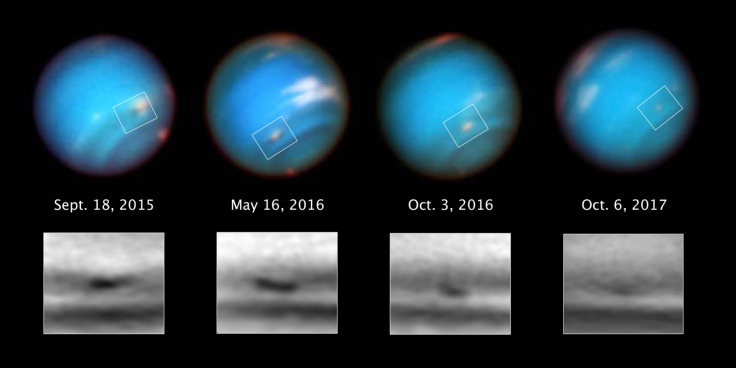A dark tornado? Nasa's Hubble captures Neptune's mysterious 'shrinking' storm for the first time
When it first appeared, the storm was big enough to stretch across the Atlantic Ocean from Boston to Portugal.

Nasa scientists using Hubble Space Telescope have noticed something weird on planet Neptune – an ominous, dark-looking storm that is shrinking.
First spotted by Voyager 2, Neptune's ominous storms have been a mystery since the late 1980s. They appear and disappear and have only been captured a few times, thanks to Hubble and its unique ability to see these features in UV light.
"We have no evidence of how these vortices are formed or how fast they rotate," said study co-author Agustín Sánchez-Lavega in a Nasa statement. "It is most likely that they arise from an instability in the sheared eastward and westward winds."
Just like Jupiter's Great Red Spot (GRS), Neptunian storms swirl in an anti-cyclonic direction and suck material from the planet's atmosphere.
However, they thrive only for a few years and end up dying, which is exactly what Hubble has seen in a storm that appeared in 2015. GRS in comparision is more than 200 years old.
Over last three years, the telescope noticed that the storm has been shrinking in an extremely weird way, Nasa said. When it first appeared, the whole thing was big enough to stretch across the Atlantic Ocean from Boston to Portugal or a little over 3,100 miles across but now it has dwindled to 2,300 miles.

"It looks like we're capturing the demise of this dark vortex, and it's different from what well-known studies led us to expect," said Michael H. Wong, lead author of the study published in Astronomical Journal. Previous simulations posited that the storms would probably move toward the equator and die with a massive outburst of cloud activity, but the latest find showcases movement towards the South Pole and a moderately slow death.
Joshua Tollefson, another researcher who worked on the observation, says the mystery storm may contain hydrogen sulphite and smell like rotten eggs. "The particles themselves are still highly reflective; they are just slightly darker than the particles in the surrounding atmosphere," Tollefson explained.
This is the first time scientists have managed to capture a weird behaviour like this. "No facilities other than Hubble and Voyager have observed these vortices," Wong added. "For now, only Hubble can provide the data we need to understand how common or rare these fascinating Neptunian weather systems may be."
Neptune's swirling storms give Nasa an opportunity to better understand the atmosphere of the distant icy planet. Plus, with James Webb Space Telescope coming into action next year, we can expect more such discoveries in the near future.






